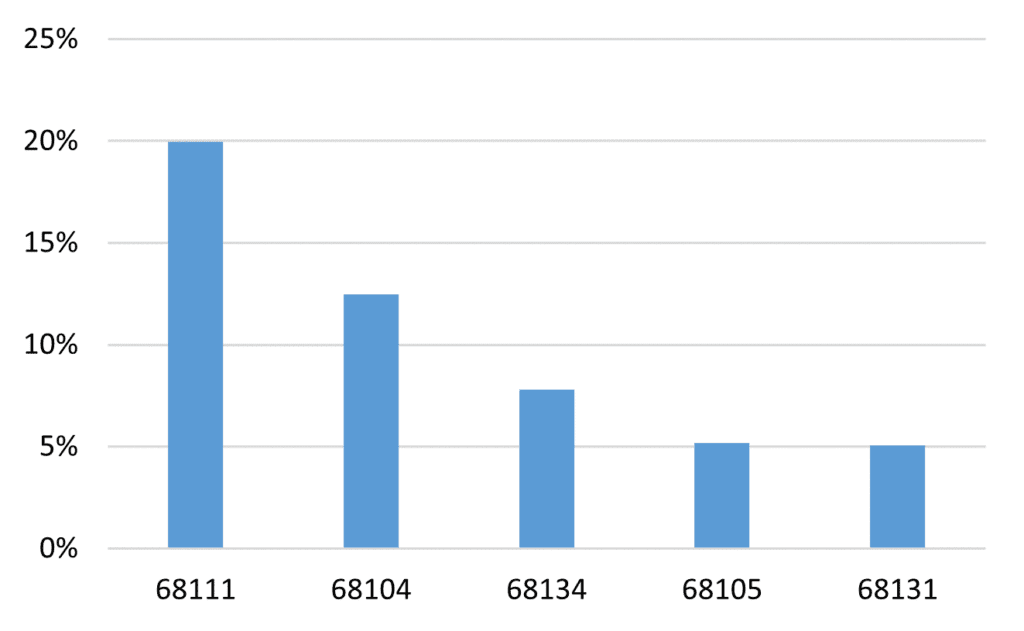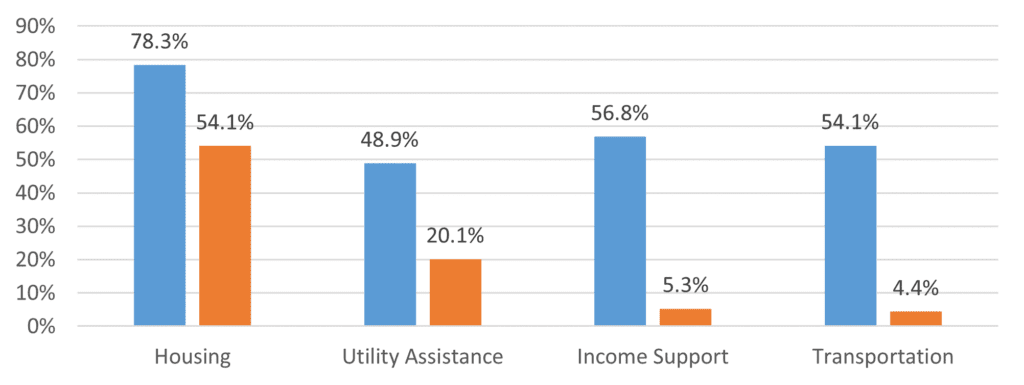Frequent Users and The Circle of Support
-
13.4% of callers and 38% of calls are from frequent users – individuals calling 211 in multiple months within a year
-
89% of frequent users sought either housing or utility assistance at least once in 2022
-
Frequent users continue to call for the same need – stressing the importance of a strong safety net while people work concurrently to upskill and achieve economic mobility
211 frequent users live in some of our areas with the highest level of poverty.
In 2022, UWM’s 211 Contact Center provided resources to more than 64,000 unique individuals in Nebraska and Southwest IA. Of those served by 211, 13% were frequent users*. These callers represent the individuals and families in our community who are experiencing high levels of need on an ongoing basis. Understanding the trends among frequent users of 211 deepens our understanding of the needs and obstacles experienced by high-need populations.
Top ZIP Codes Among 211 Frequent Callers

Poverty Rate Among Frequent Caller ZIP Codes
Overall Poverty Rate – Omaha: 9.3%
Poverty Rate 68111: 35.5%
Poverty Rate 68104: 15.3%
Poverty Rate 68134: 12.0%
Poverty Rate 68105: 18.7%
Poverty Rate 68131: 24.9%
89% of frequent users sought either housing or utility assistance at least once in 2022
Housing and utility assistance are 211 callers’ highest needs, and this is reflected by frequent users as well: 89% of frequent users sought housing or utility assistance at least once during the year. Individuals who called requesting housing or utility assistance averaged an additional two calls for housing or utility needs throughout the year, meaning even if they received assistance, they were unable to meet their housing or utility needs later in the year. Housing and utility needs far outpace any other needs category speaking to the acute need for housing and utility assistance in the community.
We’ve developed partnerships with Goodfellows, MUD, OPPD and MAACH to provide rent and utility relief for families – but it’s not enough to meet the demand. The urgency and severity of the issue requires both immediate interventions and long-term strategies ranging from continued housing assistance to expanding housing stock. In addition to efforts focused on connecting households to higher wage jobs, it’s important to implement concurrent solutions aimed at root causes and underlying disparities
Frequent users continue to call for the same need.
Persistent need is reflected by the calls of frequent users outside of housing and utility assistance, as well. In the five categories of highest need (88% of total calls), callers were most likely to call for the same issue when returning a second time to 211. The only exception to this trend within top needs was food and meals where 31% of second calls were for housing, and 28% food and meals. But this is still much higher than the overall percentage of calls looking for food and meals assistance (4%). This suggests barriers faced by frequent users are persistent and that even with the community resources at hand, they will still need assistance again for the same issue.

Percent of Second Calls in Same Category as First Calls Among Frequent Users
Percent of All Calls Among All Users
211 frequent users data points to the persistent and ongoing needs experienced by families facing financial instability. Addressing persistent need requires understanding and eliminating the unique 78.3% 48.9% 56.8% 54.1% 54.1% 20.1% 5.3% 4.4% 0% 10% 20% 30% 40% 50% 60% 70% 80% 90% Housing Utility Assistance Income Support Transportation barriers individuals and families are facing. Immediate resources provide crucial, on-the-spot assistance, offering individuals the support they need during immediate challenges. But these one-time solutions or short-term funded programs do not account for the ongoing needs of community members. Instead, individuals seek support repeatedly as they work to change their trajectory. Concurrently, long-term services act as sustained pillars, equipping people with the tools and assistance required to improve their economic mobility, fostering sustainable transformation and empowerment over time for our community.
To search the 211 database of resources click here
For more information about 211, including access to our data dashboards, click here
*Frequent user is defined as having a new recorded need in more than one month out of the calendar year.
*A new call is defined as when a caller is defined as logging a new distinct need, not following up on a previous call.